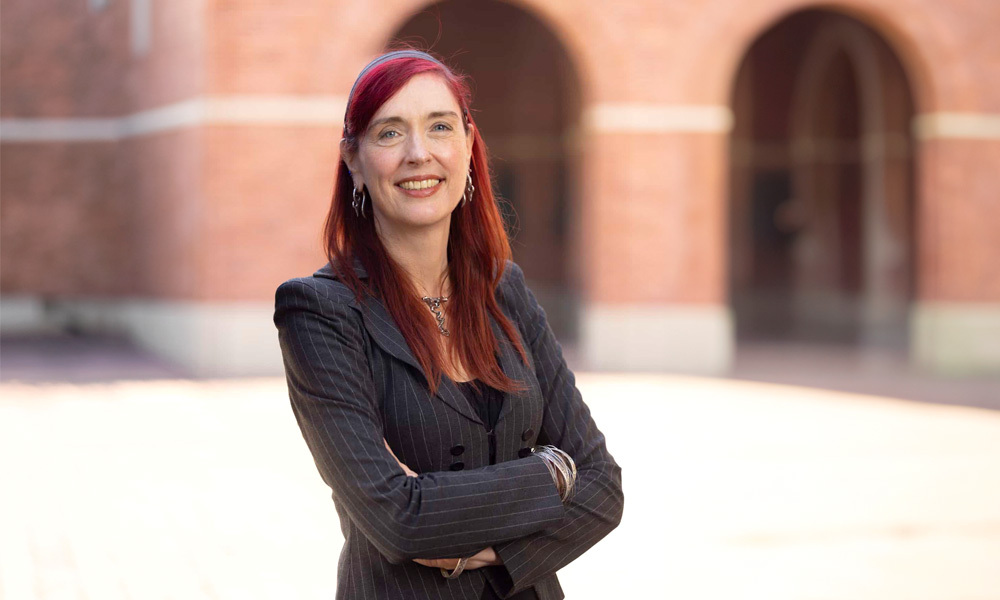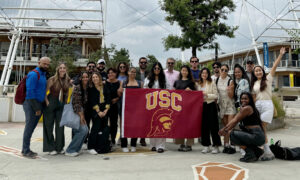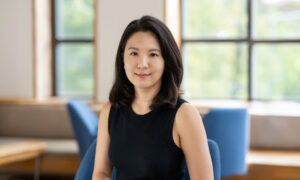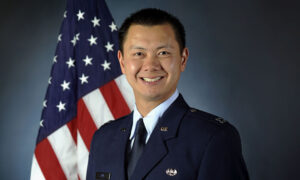Wändi Bruine de Bruin grew up on a flower farm in the Netherlands, a traditional Dutch upbringing. Her parents grew roses and orchids in greenhouses, and everyone was expected to stay in the family business.
Not Bruine de Bruin. Flowers may look pretty, but like other farming, it’s a conservative and male-dominated industry. She wasn’t interested in joining.
“I was the first in my family to go to college. I loved it so much that I wanted to stay in school as long as possible” she said.
As an academic, she’s turned that ambition into a lifelong calling.
Bruine de Bruin, Provost Professor of Public Policy, Psychology and Behavioral Science, has now been at the USC Sol Price School of Public Policy for nearly four years. (She also holds an appointment in the USC Dornsife Department of Psychology, and she’s co-director of the behavioral sciences program at the USC Schaeffer Center for Health Policy & Economics.) Her research has explored a wide range of topics, from climate change and blood pressure to political polling and food insecurity. The goal of her work is to use insights from behavioral science to achieve better policy outcomes, such as improved health and sustainability.
“If there’s a real-world problem that really needs a solution, I’m happy to try and contribute, especially if there’s a behavioral component to the problem,” Bruine de Bruin said. “If you need communications or interventions – if you need behavior change – I can probably contribute with my insights from behavioral science.”
Even though she’s dedicated to academia, she doesn’t look or sound like your typical professor. She’s a goth with red dyed hair who commutes to work on a bicycle with a basket ringed with plastic flowers. She doesn’t speak or write in jargon like other academics. For Bruine de Bruin, it’s better to be understood than to sound like the most educated person in the room.
“If you can talk to people about complicated topics in everyday language, you have a better chance that they’ll actually understand what you’re talking about and your information is more likely to be useful,” she said.
Using psychology for public policy
After fleeing the flower farm, Bruine de Bruin initially pursued clinical psychology. That aspiration was short-lived. After a couple classes at Vrije Universiteit Amsterdam, where she earned her bachelor’s and master’s degrees, she realized she did not want to be a therapist. So she chose “the most academic version of psychology that was taught at that university:” Cognitive psychology. She studied how people think and make decisions. This then led her to get a PhD in Behavioral Science at Carnegie Mellon University.
Behavioral science brings together psychology, economics and other social sciences to understand what motivates people’s behavior and how to change it. It’s not common for behavioral science to be taught in a policy school, but Bruine de Bruin said it obviously makes sense to teach it at the USC Price School.
“We’re interested in actually helping people and changing policies. Using behavioral insights to inform policies is a powerful tool that is increasingly used by policy makers,” Bruine de Bruin said.
One of the first major accomplishments in this area dealt with improving teenagers’ sexual health. As a PhD student at Carnegie Mellon University, she worked on a project that would change the way students learn sex education.
In the 1990s, many sex education programs told teenagers to be abstinent or risk dying of AIDS. And if they did have sex, they should use a condom. Bruine de Bruin and her colleagues talked to teens and found that they were very concerned about sexually transmitted infections and wanted to take actions to avoid them.
But the problem was they didn’t know how to broach the subject with their partner. Bruine de Bruin and her colleagues developed a video to teach them to think about what they want and then talk about it. Six months later, viewers were less likely to have sex, and if they did, they were more likely to use a condom and less likely to test positive for the sexually transmitted infection Chlamydia, as compared to a control group.
Years later, the Obama Administration recognized the video as one of the few sexual education materials developed since the 1980s that worked.
“One thing that we do in behavioral science is, when developing communications or interventions, we don’t assume that we know how to change people’s behavior,” Bruine de Bruin said. “We actually talk to the intended audience to find out what the issue is.”
Communicating (and eating) better
Much of her work has lately focused on climate change, a huge policy challenge that will require millions of people to change the way they eat, travel and power their homes and vehicles. Bruine de Bruin doesn’t just talk the talk with her research in this realm. She rides the flower bike to work.
Bruine de Bruin travels six miles from her home in Echo Park to USC’s downtown Los Angeles campus using a Dutch bike with red and green Christmas lights above the back tire and white plastic flowers attached to a handlebar basket. It’s a bike she seems quite fond of, as she was eager to share pictures.
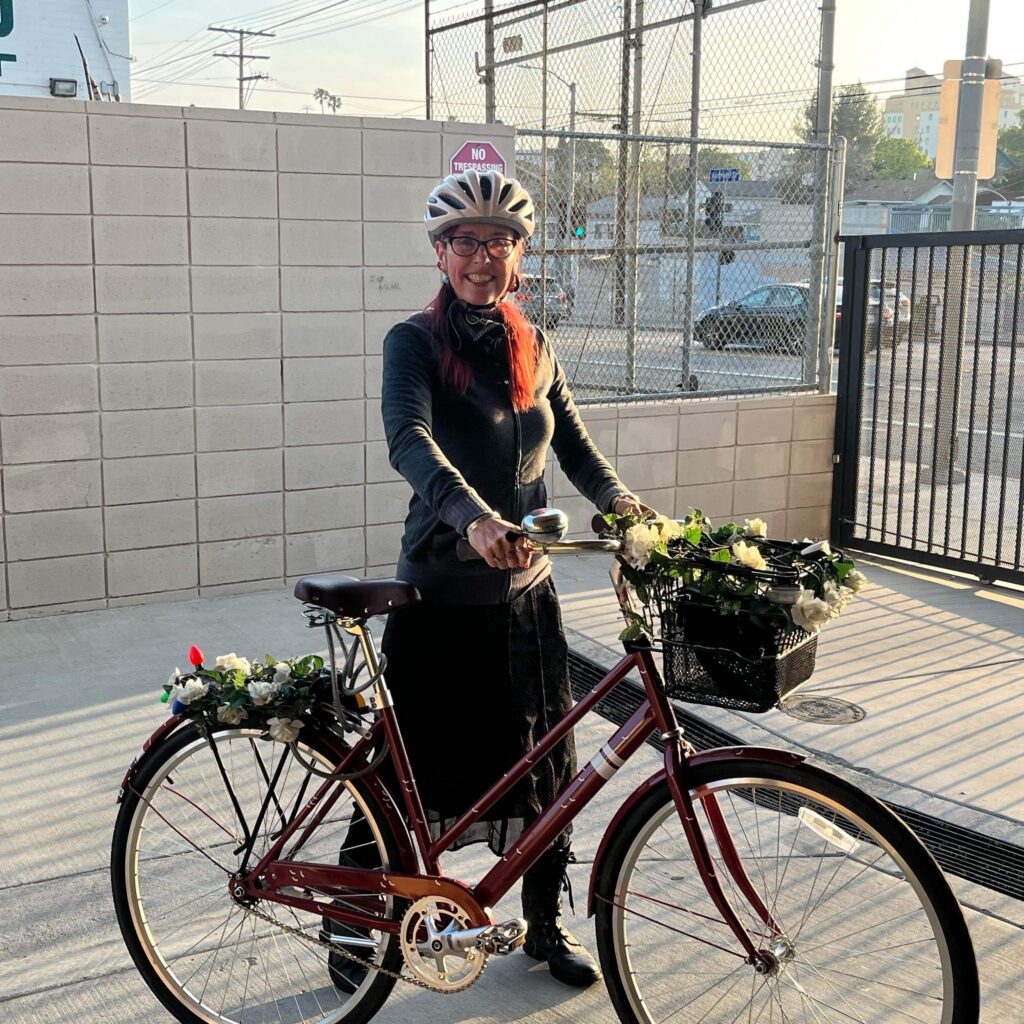
She’s also a vegan who notes that eating less meat is a lesser-known way to help the planet, given all the carbon dioxide produced to make meat. She makes these choices to help the environment, but “I also don’t like driving or eating meat, so that helps.”
Bruine de Bruin admits she was pulled into climate change research in the early 2000s, before she understood why she needed to be concerned about it. Environmental scientists and engineers recruited her because of her work on informing public perceptions of health risks. She now analyzes the Lloyd’s Register Foundation World Risk Poll of roughly 125,000 people to understand what drives public concerns about climate change.
She found that college educated people were more likely to be concerned about climate change. There is also evidence that personal experience with severe weather may inform people’s climate change concerns.
It doesn’t require a college degree to see that extreme weather – such as fires, floods and the heatwaves baking the nation this summer – has gotten worse. That suggests climate scientists, policymakers and members of the media should use concrete examples and talk about extreme weather when discussing climate change.
Bruine de Bruin also worked with the United Nations Foundation and Intergovernmental Panel on Climate Change to find out how well people understand climate change terminology. For example, climate communication often uses the word “mitigation,” yet many people confuse it with “mediation,” according to Bruine de Bruin’s research. When she and her colleagues asked about the word “adaptation,” some respondents believed it meant turning a book into a movie.
Bruine de Bruin also identified alternative wording that used everyday language. “Mitigation,” for example, could instead be described as “actions to fight climate change.”
Yet convincing scientists to use simpler language hasn’t been easy. Some are concerned that if they speak in everyday language, they won’t sound like experts. Others are afraid they will sound like they’re talking down to people.
“But when you use everyday language about a difficult, complicated topic, you are not talking down to people. You’re actually just making something really complex easier to understand,” Bruine de Bruin said. “You’re not telling people Sesame Street stories. You are explaining complex things such as climate change or saving for retirement or blood pressure.”
A good teammate and goth fan
According to her colleagues, Bruine de Bruin has great research instincts and insights, and is a generous mentor and collaborator.
“The first thing that stands out is her sharp intelligence,” said Kayla de la Haye, a scientist working at USC’s Center for Economic and Social Research. The two have worked together on a project that tracks food insecurity across Los Angeles County.
“Whenever we are wrestling with complex and confusing findings, Wändi has a talent for drawing on her expertise and identifying the most important insights,” de la Haye said.
“Wändi’s positivity is infectious. She genuinely loves the work she does as a researcher and professor, and this joy is contagious for the whole research team,” de la Haye added.
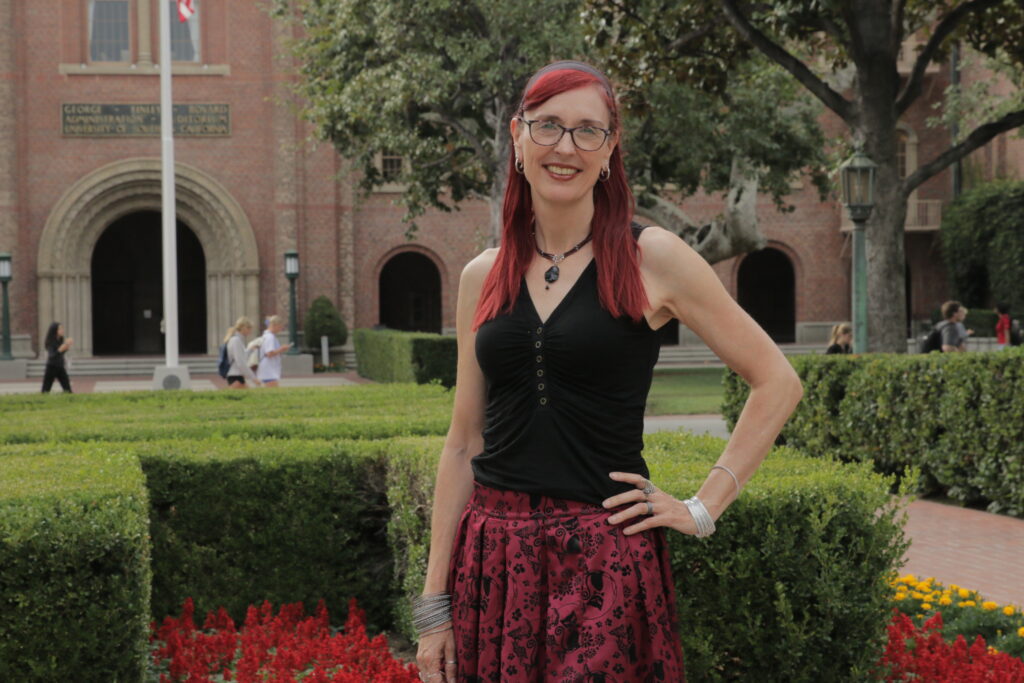
Beyond work, Bruine de Bruin loves swimming, dancing and goth music. Despite the reputation of goths being dark and mysterious, Bruine de Bruin is invariably friendly and open and is anything but a misanthrope. When the goth revelation prompted more questions, she pointed out a flaw in those queries.
“Why are you asking questions about going to goth clubs in the past tense? I still go dancing at goth nights in L.A.,” she said. “Goth is quite big in L.A., among people of all ages, genders, and ethnicities. Neither I nor L.A. ever grew out of the goth phase.”
There is, as one might expect, a lot of obscure goth music. But her favorite musicians that are more mainstream are The Cure, The Sisters of Mercy and Siouxsie & the Banshees. All of these bands, she noted, played in L.A. this year.
For Bruine de Bruin, her goth fandom is also a love story. In 2008, she met a man who DJ’d a popular 80s night in a Pittsburgh club. He played a lot of goth music to impress Bruine de Bruin, It worked. That DJ is now her husband.
Bruine de Bruin said there are no connections between being a goth and her research interests. “Not yet,” she said.
Making life better
Bruine de Bruin has used her research to reveal other useful practical insights. After many pollsters failed to predict former President Donald Trump’s election victory in 2016, Bruine de Bruin and her colleagues found a more revealing polling method. Instead of asking people who they planned to vote for, they asked who their friends and families planned to vote for. The latter “social circle” polling question was more accurate.
“Sometimes people don’t know yet who they’re going to vote for, or they don’t want to tell the pollsters. But they are less reluctant to share what percent of their friends and family they think are going to vote for the different candidates,” Bruine de Bruin said.
Beyond the problem of jargon, Bruine de Bruin has conducted other research that suggests experts aren’t always great at communicating.
A few years ago, she received a letter from her health insurer about her blood pressure but didn’t understand any of it. She initially assumed she wasn’t familiar with the blood pressure numbers because her blood pressure was healthy. It turns out, she was hardly alone in not understanding.
After surveying thousands of patients, her research revealed that most Americans don’t know the healthy range for blood pressure. It’s an important finding, since high blood pressure is quite common and can be a silent killer if left untreated. Bruine de Bruin and her colleagues noted that doctors often don’t explain blood pressure readings to their patients.
“Often patients come in, their blood pressure is taken and then it’s not discussed,” she said. “And that is a missed opportunity for helping people understand what the right level is for their blood pressure. Such understanding is important because high blood pressure is a silent killer.”
Such research goes to the heart of what motivates her work. She gravitated to behavioral science because it provides evidence-based insights for understanding how people process information, make decisions and change their behavior.
“I would like to use these insights to find ways to develop better communications about pressing topics such as climate change and health – and maybe help to make people’s lives a little bit better.”
